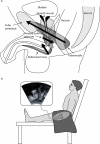Novel insight into the dynamics of male pelvic floor contractions through transperineal ultrasound imaging
- PMID: 22902016
- PMCID: PMC4106154
- DOI: 10.1016/j.juro.2012.06.028
Novel insight into the dynamics of male pelvic floor contractions through transperineal ultrasound imaging
Abstract
Purpose: Transperineal ultrasound imaging enables the minimally invasive assessment of pelvic floor muscle function. Although commonly used in women, the approach has rarely been reported in men. This approach has advantages because the midsagittal view visualizes a bony landmark and the entire urethral length. This allows investigation of the displacement of multiple points along the urethra and the unique mechanical actions of multiple muscles that could influence continence. We used a new transperineal ultrasound technique to compare the relative displacement of urethrovesical junction, anorectal junction and distal urethra during voluntary pelvic floor muscle contractions in continent men.
Materials and methods: We performed measurement and comparison of urethral displacement at specific urethral regions in 10 continent men (age range 28 to 41 years). Measures made on 2-dimensional midsagittal plane ultrasound images included the displacements of specific points along the urethra. Anatomical considerations suggest that these are caused by contraction of the levator ani, striated urethral sphincter and bulbocavernosus muscles. Pearson's correlation coefficient was used to investigate the relationship between displacements of pairs of points.
Results: Data show individual variation in displacement of the distal urethra (striated urethral sphincter contraction) and urethrovesical junction (levator ani contraction). A strong inverse linear relationship (0.723) between displacements of these points indicates 2 alternative strategies of urethral movement.
Conclusions: Transperineal ultrasound imaging allows the simultaneous investigation of multiple pelvic floor muscles by measuring urethral displacement. The data provide evidence of different but coordinated strategies of urethral displacement in men.
Copyright © 2012 American Urological Association Education and Research, Inc. Published by Elsevier Inc. All rights reserved.
Figures



Similar articles
-
Validity of Estimation of Pelvic Floor Muscle Activity from Transperineal Ultrasound Imaging in Men.PLoS One. 2015 Dec 7;10(12):e0144342. doi: 10.1371/journal.pone.0144342. eCollection 2015. PLoS One. 2015. PMID: 26642347 Free PMC article.
-
A new method to quantify male pelvic floor displacement from 2D transperineal ultrasound images.Urology. 2013 Mar;81(3):685-9. doi: 10.1016/j.urology.2012.11.034. Epub 2013 Jan 17. Urology. 2013. PMID: 23332998 Free PMC article. Clinical Trial.
-
Influence of body position on dynamics of the pelvic floor measured with transperineal ultrasound imaging in men.Neurourol Urodyn. 2020 Mar;39(3):954-961. doi: 10.1002/nau.24301. Epub 2020 Feb 6. Neurourol Urodyn. 2020. PMID: 32027772
-
Utility of 2D-ultrasound in pelvic floor muscle contraction and bladder neck mobility assessment in women with urinary incontinence.J Gynecol Obstet Hum Reprod. 2020 Jan;49(1):101629. doi: 10.1016/j.jogoh.2019.101629. Epub 2019 Sep 6. J Gynecol Obstet Hum Reprod. 2020. PMID: 31499282 Review.
-
The pelvic floor muscles: muscle thickness in healthy and urinary-incontinent women measured by perineal ultrasonography with reference to the effect of pelvic floor training. Estrogen receptor studies.Neurourol Urodyn. 1997;16(4):237-75. doi: 10.1002/(sici)1520-6777(1997)16:4<237::aid-nau2>3.0.co;2-f. Neurourol Urodyn. 1997. PMID: 9220475 Review.
Cited by
-
[Imaging for urinary incontinence].Urologe A. 2015 Jul;54(7):963-71. doi: 10.1007/s00120-015-3872-6. Urologe A. 2015. PMID: 26162272 Review. German.
-
Validity of Estimation of Pelvic Floor Muscle Activity from Transperineal Ultrasound Imaging in Men.PLoS One. 2015 Dec 7;10(12):e0144342. doi: 10.1371/journal.pone.0144342. eCollection 2015. PLoS One. 2015. PMID: 26642347 Free PMC article.
-
Clinical utilization of musculoskeletal sonography involving non-physician rehabilitation providers: a scoping review.Eur J Phys Rehabil Med. 2016 Apr;52(2):253-62. Epub 2015 Jul 16. Eur J Phys Rehabil Med. 2016. PMID: 26201705 Free PMC article.
-
The measurement of membranous urethral length using transperineal ultrasound prior to radical prostatectomy.Scand J Urol. 2018 Aug;52(4):263-268. doi: 10.1080/21681805.2018.1484509. Epub 2018 Jul 25. Scand J Urol. 2018. PMID: 30041561 Free PMC article.
-
Effect of different postures of Pilates combined with Kegel training on pelvic floor muscle strength in post-prostatectomy incontinence.Int Urol Nephrol. 2023 Mar;55(3):519-527. doi: 10.1007/s11255-022-03423-x. Epub 2022 Dec 19. Int Urol Nephrol. 2023. PMID: 36534222
References
-
- Gosling JA. The structure of the female lower urinary tract and pelvic floor. Urol Clin North Am. 1985;12:207. - PubMed
-
- Bhatia NN, Bergman A, Karram MM. Effects of estrogen on urethral function in women with urinary incontinence. Am J Obstet Gynecol. 1989;160:176. - PubMed
-
- Heidler H, Casper F, Thuroff JW. Role of striated sphincter muscle in urethral closure under stress conditions: an experimental study. Urol Int. 1987;42:195. - PubMed
-
- DeLancey JO. Structural support of the urethra as it relates to stress urinary incontinence: the hammock hypothesis. Am J Obstet Gynecol. 1994;170:1713. - PubMed

